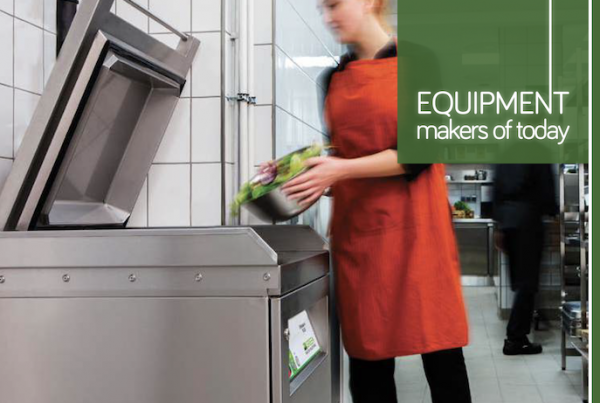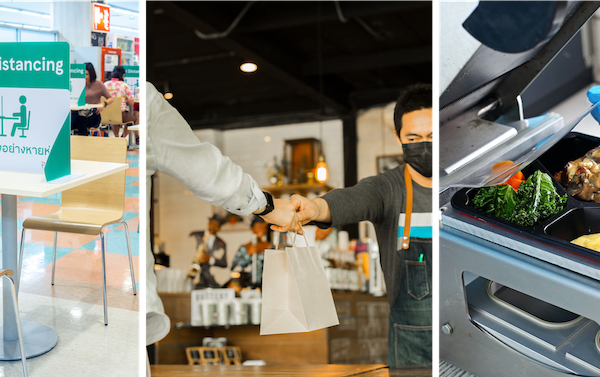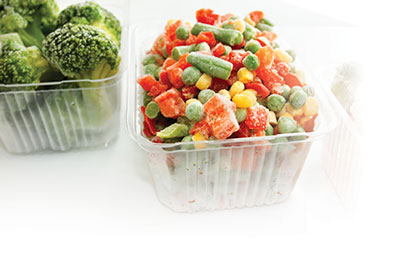 Refrigeration is simply the removal of heat from an item or to bring down the temperature from its present ambient temperature. In early civilisation, the Hebrews, Greeks and Romans shoved snow into storage pits and insulated the pits to provide a vessel for cooling. Ancient Egyptians filled ear then jars with boiled water and placed it on the roof for night’s air to cool it. Cellars, springhouse with cool running water from a stream trickling beneath storage boxes were commonly used methods for heat removal. However, food could not last long and people have died from eating spoiled food during warmer weathers.
Refrigeration is simply the removal of heat from an item or to bring down the temperature from its present ambient temperature. In early civilisation, the Hebrews, Greeks and Romans shoved snow into storage pits and insulated the pits to provide a vessel for cooling. Ancient Egyptians filled ear then jars with boiled water and placed it on the roof for night’s air to cool it. Cellars, springhouse with cool running water from a stream trickling beneath storage boxes were commonly used methods for heat removal. However, food could not last long and people have died from eating spoiled food during warmer weathers.
As time advanced, the evaporation technique was discovered to remove heat followed by vapor compression using air and subsequently ammonia was used as a coolant. Ammonia is one of the most common of liquids called ‘refrigerants’ and widely used to absorb heat from inside insulated containers; or what we know as refrigerators. But, every time we reach into our fridge how often do we think about how this stainless steel box works? Par ticularly for the F&B industry, refrigerators come in various shapes, sizes and functions.
Based on the science that anything that evaporates is removal of heat, how does it work in refrigeration? Typically, Freon gas is used in the refrigerant and the 4 major parts in a refrigeration cycle includes:
• The compressor is the core of your fridge. It works like a hear t. As the refrigerant passes through, it gets compressed into pressurised vapour, and is extremely hot. Therefore, a high amount of power is allocated to accommodate the heat transmission from low temperature space to high temperature space.
• The condenser removes the heat from the vapour and turns it into liquid. It acts as a heat exchanger to release the heat from inside the refrigerator into the atmosphere via coils, usually on the body of the fridge (that is why the sides of your fridge feel warm when you load things inside.
• The liquid then moves through an expansion device where pressure is lowered to provide a vigorous and rapid evaporation of the refrigerant.
• As the evaporating freon passes through, the evaporator removes heat from the cabinet. After the refrigerant absorbs heat from the cabinet, it then being pumped back to the compressor and this cycle is repeated until the desired amount of heat is removed.
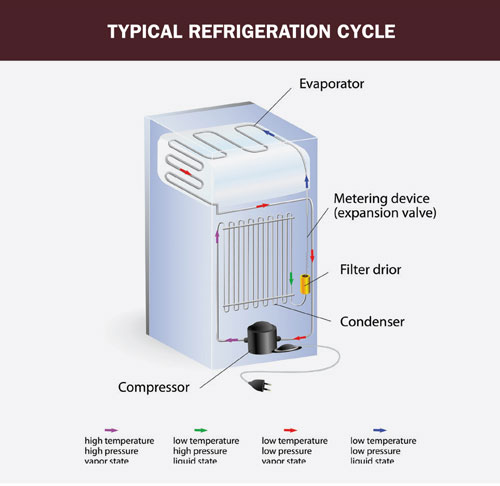 FROM REFRIGERATION TO BLAST CHILLING
FROM REFRIGERATION TO BLAST CHILLING
What began as a box to preser ve raw materials have been constantly refined and today; kitchens can actually keep precooked items for weeks using blast chilling technology. This has enabled better planning, reduced stress especially when catering for large par ties and lower purchasing costs. It also helps to assure food safety standards are met as bacteria multiply fastest between +8 °C and +68 °C hence its growth must be stopped within 90 minutes other wise food might be dangerous for consumption. It works by forming microcrystals on products instead of moisture evaporation which dehydrates food thereby retaining cooked food’s quality, appearance, nutritional value and flavours. It is also helpful for kitchens to keep any raw and seasonal ingredients that it wants to offer as specials to its customers. Blast chilling is now a norm especially in catering or banquet kitchens but it is not an appliance that every kitchen requires. However, a refrigerator is a must for any commercial kitchen hence the focus is on the basic refrigeration practices. Working with our associates; we present a closer look at the technology and the different categories of refrigeration available so that you may be more informed when shopping for your next fridge.
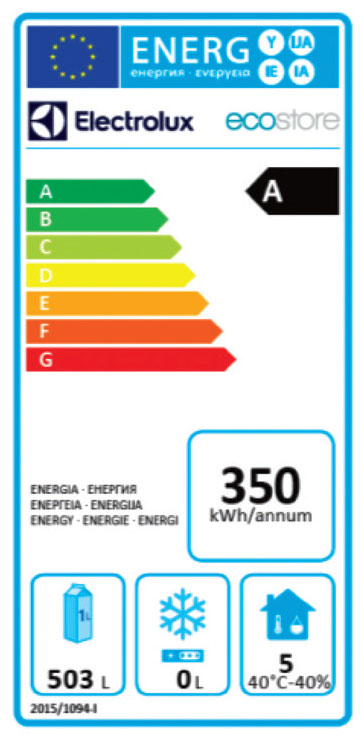 ACHIEVING INTERNATIONAL STANDARDS
ACHIEVING INTERNATIONAL STANDARDS
In a study carried out by University of Bristol; it documented the energy use of a range of catering refrigeration equipment under actual day-to-day operations for 7 days. The 2-door upright fridge consumed 18.5% of the total 100% of energy used cumulatively by these units. On a rough estimate, that would mean 20% of your kitchen’s total energy consumption may come from refrigeration alone. What steps can a manufacturer take to provide users a better carbon footprint?
The European Union recognises the impact of such machines and to maintain a respectable standard; it established an energy consumption labelling scheme that rates appliances in terms of a set of energy efficiency classes from A (most energy efficient) to G (least efficient) on the label.
It is compulsory for every refrigeration appliance sold in Europe to carry an energy labelling by July 2016 and you want to look out for this label.
The test, performed in a controlled environment over 48 hours where a loaded (with testing packs) fridge is opened 6 times per hour over 12 hours for 7 seconds at each time. Energy Label is given to units that passes the rigorous test when each testing pack is correctly preserved within the safety range -1/5°C for refrigerators and <-15°C for freezers.
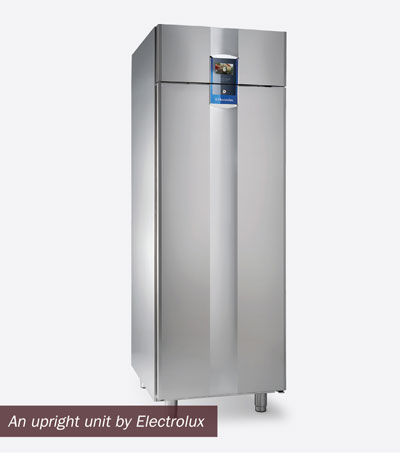 Electrolux’s range of chillers, freezers and undercounters are tested and confirmed to achieve the Climatic Class 5, fitting the most critical working condition yet maintaining a close watch on efficiency. It is approved to carry the Energy Label with contributing features like:
Electrolux’s range of chillers, freezers and undercounters are tested and confirmed to achieve the Climatic Class 5, fitting the most critical working condition yet maintaining a close watch on efficiency. It is approved to carry the Energy Label with contributing features like:
• Clever cooling system design and air distribution system (32%)
• Improved insulation (26%)
• High efficiency components (20%)
• R290 Gas and Cyclopenthane (12%)
• Advanced Electronic Function (10%)
As each manufacturer is bound to use the same methodology in order for data to be comparable, Energy Label assures customers their chosen refrigerators are certified efficient to internationally governed standards. A refrigerator is capable of many roles; if only it is fitted with the correct components suited for the specific reason. In light of this, we have collaborated with manufacturers of refrigeration as they shared tips on how to pick the best model.
REFRIGERATION FOR THE KITCHEN
Whether they are hidden under the counter or standing against the wall, a commercial kitchen is never without a refrigerator or freezer. Despite being crucial equipment for every kitchen, many tend to ignore the importance of investing in a good reliable unit. It is the first line of protection against spoilage of produce. As a restaurateur, buying the best quality brings you recognition if the produce is kept fresh and served fresh. Badly stored food also causes food poisoning.
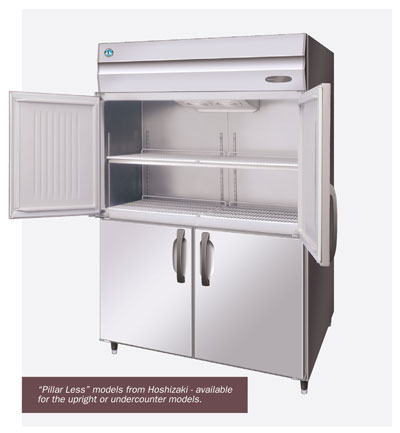 What’s in a refrigerator?
What’s in a refrigerator?
Kaz Yamashita of Hoshizaki shares an insight; “the pull down time (the recovery time for a unit to climb back to its optimum temperature after you close the door) is an important factor. Fridges in the kitchen go through constant abuse. Doors are opened and slammed constantly. It is normally filled to the brim and the choice of containers used to hold food can affect its performance”.The key to maintaining an ideal temperature is circulation of air and he explains that recovering temperature loss, maintaining temperature and allowing flow of the air within the cabinet all contributes to a fridge’s performance. Furthermore, the hot environment within the kitchen pushes the compressors to work over time to cool down the unit and that is why compressor break downs happen.
If food is pride of your restaurant, serious considerations will be required:
FUNCTION – Upright, counters, drawer systems, what do you need it for? Small kitchens love counters whereas drawers allows better organisation in the kitchen.
EASE OF REACH– Door types (full, half or glass)? For example, Hoshizaki’s Goldline has an option of a pillar-less cabinet which fits a range of tray and container sizes. There are also units with rails for GN pans if your kitchen works on a large production capacity.
ACTUAL STORAGE SPACE– For undercounters, look at the actual capacity space that the unit offers. The space for the refrigeration system should be compact without compromising its performance and the savings in space is a storage luxury for compact kitchens today.
PLACEMENT & MAINTENANCE– recognise a refrigerator never stops working. Ask your dealer and kitchen layout designer where is the best place to put a fridge; taking into account walking flow and heat dispersion. Ensure warranty, service periodical maintenance is well documented by the dealer.
ADDITIONAL SYSTEMS– if its affordable or important, there are optional additionals such as temperature monitoring alarm, shelves with stoppers to prevent overloading the unit, self-closing doors or smooth drawer rails to name a few.
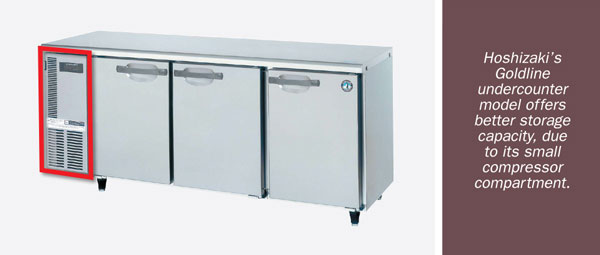
It’s time we look at fridges beyond the stainless steel box and understand the numerous features and functions that manufacturers have put in over the years to enhance the primary purpose “to keep your food in the cabinet in a right and stable temperature at all times”.
RETAILING IT RIGHT!
More food operators are offering options beyond the dining table with items in its menu being pre-cooked and retailed. As technology continues to improve food preparation processes, it makes good sense to expand your market reach with ready-to-eat items. With this in mind, we asked Liebherr to share insights on purchasing a model for its merchandising endeavours.
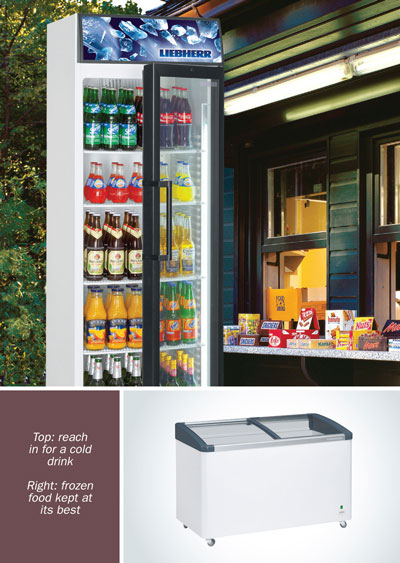 FULL LENGTH / UPRIGHT GLASS DOORS
FULL LENGTH / UPRIGHT GLASS DOORS
A clear glass fridge entices and encourages purchase hence an outstanding presentation is important. Look for LED lights as they are brighter, last longer yet consume less energy. While the market standards provide a temperature range of -15 to -24°C, Liebherr allows for more items to be kept with its -10°C to -24°C range. A bottom mounted condensing unit is easy to clean while a top mounted may cause debris to be collected in the unit on the floor. Glass consumes more energy, as coolness is lost through the glass hence you want to calculate how much extra cost is reasonable to bear. Glass doors and interior shelves require constant maintenance so you want to look for designs and fittings that are simple to access and clean.
CHEST CHILLERS/ FREEZERS
Chest freezers provide a wide view of your food retail selections and are also easier to reach for pint-sized consumers. Although unnoticeable, Liebherr designed chests with a 5-degree tilt angle designed to make it easier to stock and to remove goods for purchase, and to give customers a sales-provoking view.
Tabletop units can be used for beverages, dairy products, cosmetics, expensive tea and anything which needs a cool constant temperature.
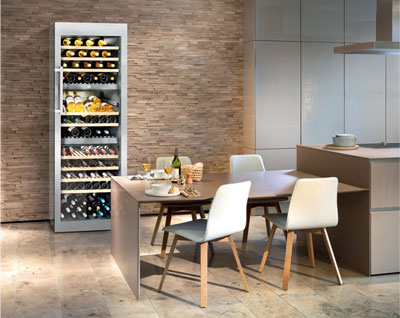 WINE CHILLER
WINE CHILLER
Liebherr’s wine chillers provide degree-accurate temperatures between +5°C and +20°C so that you can keep different wines at their optimum drinking temperature. Multi-temperature wine cabinets allow simultaneous serving of champagne and a red wine at its ideal serving temperature. As wines are often being bottled in coloured brown or green glass bottles, invisible ultraviolet (UV) rays within the light spectrum can cause some visual impact – red wines fade and white wines take on a golden yellow colour through absorption of the troublesome rays. Liebherr’s solution uses insulated glass doors with special UV protection and double-glazed construction to reflect away most of the damaging UV radiation.
SPACE & CAPACITY
Measure how much space is required; including door ways for the machine to pass through. A large external dimension does not necessarily mean the interior will hold as much. Bigger capacities allow you to put more goods, reducing the frequency of stock replenishment which translates to cost savings in manpower.
FOR THE TROPICAL CLIMATE
Merchandising cabinets need to be clean and presentable at all times but tropical weather may cause sweaty cabinets. Liebherr’s solution includes:
• Enhanced insulation capabilities
• Anti-condensation loop
• Variable Capacity Compressor for optimum performance under extreme ambient temperature
• Magnetic core in the units’ seals ensure that doors close securely; preventing temperature loss
• Air circulation inside creates temperature layering for the air temperature to even out, keeping foods fresh to the crisp!
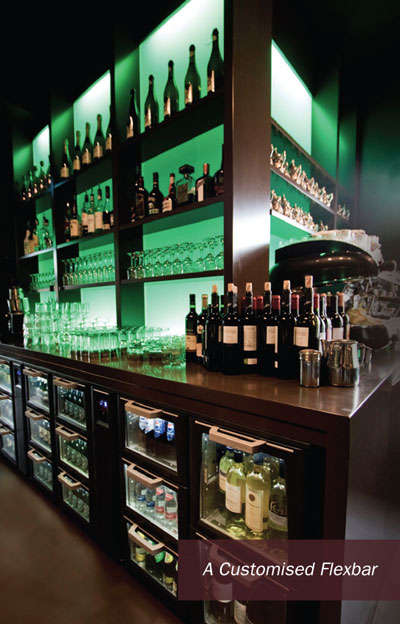 COOLING THE BAR
COOLING THE BAR
Bars, watering holes, clubs or lounges require a dedicated chilling system for its drinks. Gamko, a company specialising in professional drinks cooling, walks us through selecting a solid chiller. It recognises that each bar has its own story and believes that the bar counter is an expression of the story. The process of customising a bar starts with:
Step 1: Provide a draft– Most clients would already have a rough idea of how it looks like and this draft (sketch) is the star ting point for Gamko’s Design Process to propose the best design from the get-go.
Step 2: Complete a Questionnaire– It comprises questions for both the client and dealer; giving the company a solid over view of the bar’s configuration and other product groups required before the Bar Engineer comes up with a technical drawing. The questionnaire also acts as documentation of the discussion.
Step 3: Impressions with 3D-drawings– 3D impressions of the bar will be created to provide a clear over view from all dimensions; in order for the client to easily see if anything was left out or requires adaptation.
Step 4: Quotation matches CAD and 3D-drawing– Clients are then given a proposed quote according to the CAD and 3D drawings.
In between these steps, clients can select the required products and machines to be fitted into the bar. Among the products available include:
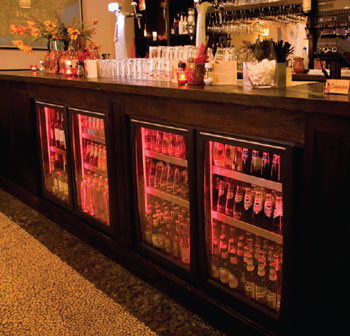 • Bottle coolers – to store and maintain bottled drinks at the correct temperature that refreshes the person drinking it.A unit with energy – efficient properties as it won’t be switched off and looks modern with clear transparent glass will win the purchase deal for you.
• Bottle coolers – to store and maintain bottled drinks at the correct temperature that refreshes the person drinking it.A unit with energy – efficient properties as it won’t be switched off and looks modern with clear transparent glass will win the purchase deal for you.
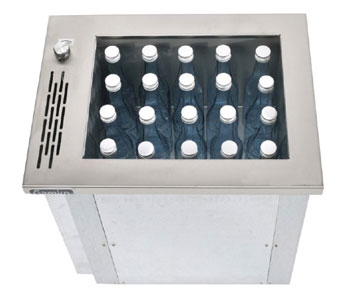 • Counter Top Coolers – these designs are attention-grabbing yet practical by providing a quick view from above so that you are able to swiftly serve wine, liquer or vodka.
• Counter Top Coolers – these designs are attention-grabbing yet practical by providing a quick view from above so that you are able to swiftly serve wine, liquer or vodka.
• Bottles & glass freezers – used to rapidly freeze drink glasses and for serving ice cold bottles of liquer and spirits like vodka or gin. A plug-ready unit will expedite the process.
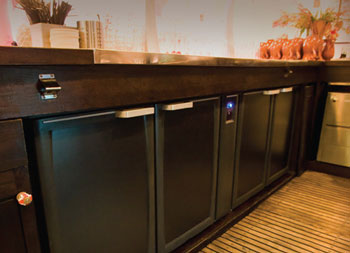 • Keg coolers – for storing beverages that come in a keg and Gamko’s units comes as ready-to-assemble panels which makes it easier to fit at concealed and difficult to access places. Panel construction keg cabinets are also suitable for pre-chilling kegs, crates or bottle drinks.
• Keg coolers – for storing beverages that come in a keg and Gamko’s units comes as ready-to-assemble panels which makes it easier to fit at concealed and difficult to access places. Panel construction keg cabinets are also suitable for pre-chilling kegs, crates or bottle drinks.
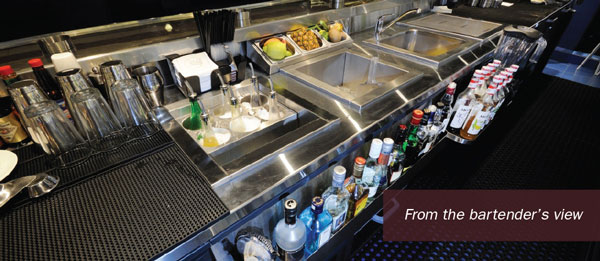
MODULAR BAR SYSTEMS
Pioneered by Gamko back in 1979, detachable sections gave customers the freedom to switch their bar area around. Known as Flexbar today, bar owners can create their bespoke bar designs by configuring with doors, drawers, bottle racks, refrigerated or unrefrigerated segments, and coffee waste drawers. Gamko’s Total Bar Solutions are intuitively designed to enable easy access to drinks, glasses and cups at the front bar and back bar. Meanwhile, solid drawer and door modules offer greater flexibility for the front bar or back bar by choosing required modules, where they are needed and at specific temperature (chilled, ambient or heated).
BUILDING YOUR OWN FRIDGE
How many of us think of designing a fridge for our home? You can go out and find some nifty and arresting designs of fridges in the market but most have a unit in silver, black or grey. After all; we just need chilling and freezing proper ties isn’t it? Perhaps you think the same for your industrial kitchen as well. However, you do have options to get a fridge that fits your kitchen’s requirements. We spoke to Fridgemaker and found out what you need to know before selecting customisation.
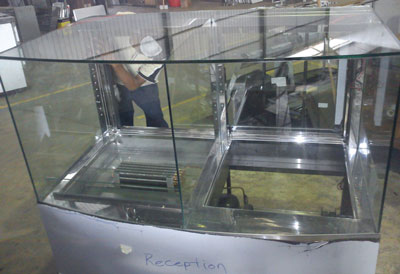 When should one consider a specially built fridge?
When should one consider a specially built fridge?
If a ready-made fridge conflicts against your interior; particularly if it is a front-of-house unit. Perhaps you have products to be stored or presented that require very specific temperature that commercial units do not have. It could even be the work flow (ergonomics) where the space is unable to accommodate a standard unit. Sometimes corporate customers order customised fridges as gifts as well.
What should customers know about customisation?
According to Robin Low, customers usually already know what they want the fridge to look like or do. However, before making the choice, one must understand its limitations – such as temperature against humidity – can the products withstand temperature fluctuations, ventilation and will it be a practical solution? For example, to display a product in an open reach- in showcase in an environment where ambient temperature is 30°C would be rather impossible.
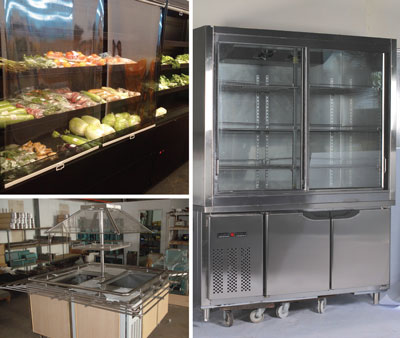 The working relationship
The working relationship
To begin conceptualising a custom refrigerator or freezer, the fabricator will have to first know the basic information:
• What are you going to put inside? As ever y product has its latent heat, just the difference between poultry and beef already makes a difference.
• Do you really need a customised unit? A fabricator must know whether the product really needs a special fridge as some customers may not know that the design that they want actually exists as a standard model from some manufacturers.
• What kind of environment will the fridge be placed in and what is the humidity? Is there proper ventilation or too much air disturbance? Is there space for future maintenance? Remember that a fridge gets cold by removing heat within NOT putting cold air in the chamber therefore proper ventilation is very important.
• What is the customer really keen on prioritising? Is it more storage, different outlook, more ergonomic or optimum preservation of the product?
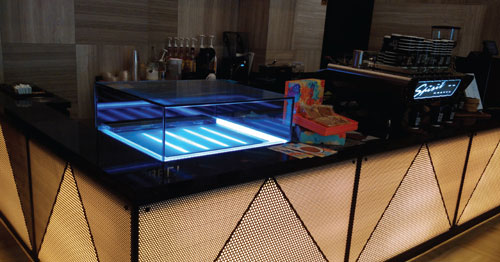
Of course, the budget. As there are many ways to do customisation, a budget helps a fabricator source for more options. A customer may want a certain design; although the budget doesn’t allow it doesn’t mean there aren’t cheaper options.
Time is one of the most critical components. To fabricate a customised refrigerator, there are many details to work on and many times, different components need to be sourced, therefore reasonable timing would be appreciated by a manufacturer!









